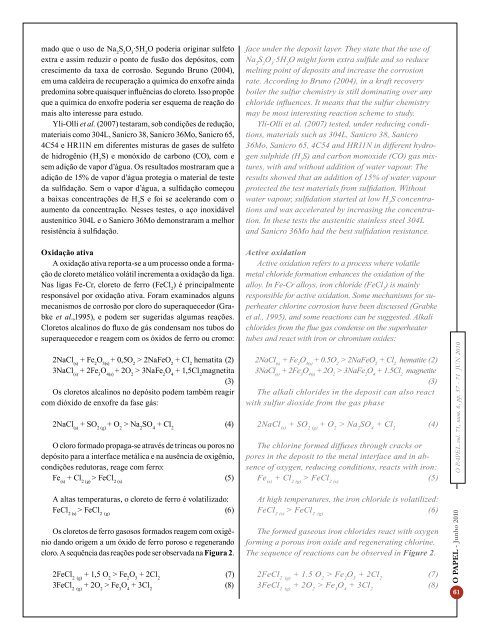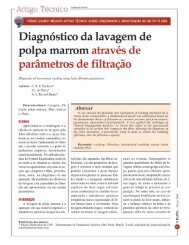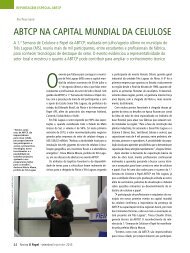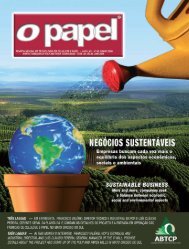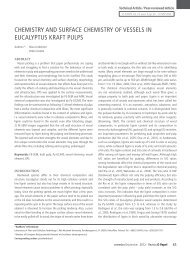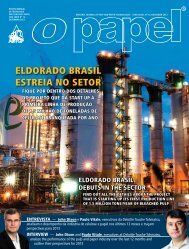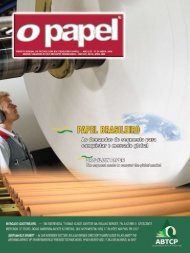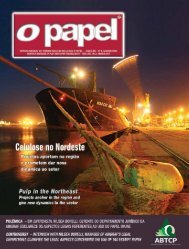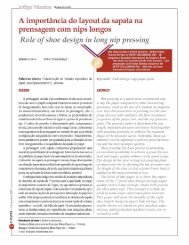Brasil na PulPaper - Revista O Papel
Brasil na PulPaper - Revista O Papel
Brasil na PulPaper - Revista O Papel
Create successful ePaper yourself
Turn your PDF publications into a flip-book with our unique Google optimized e-Paper software.
mado que o uso de Na 2S 2O 3·5H 2O poderia origi<strong>na</strong>r sulfetoextra e assim reduzir o ponto de fusão dos depósitos, comcrescimento da taxa de corrosão. Segundo Bruno (2004),em uma caldeira de recuperação a química do enxofre aindapredomi<strong>na</strong> sobre quaisquer influências do cloreto. Isso propõeque a química do enxofre poderia ser esquema de reação domais alto interesse para estudo.Yli-Olli et al. (2007) testaram, sob condições de redução,materiais como 304L, Sanicro 38, Sanicro 36Mo, Sanicro 65,4C54 e HR11N em diferentes misturas de gases de sulfetode hidrogênio (H 2S) e monóxido de carbono (CO), com esem adição de vapor d’água. Os resultados mostraram que aadição de 15% de vapor d’água protegia o material de testeda sulfidação. Sem o vapor d’água, a sulfidação começoua baixas concentrações de H 2S e foi se acelerando com oaumento da concentração. Nesses testes, o aço inoxidávelaustenítico 304L e o Sanicro 36Mo demonstraram a melhorresistência à sulfidação.face under the deposit layer. They state that the use ofNa 2S 2O 3·5H 2O might form extra sulfide and so reducemelting point of deposits and increase the corrosionrate. According to Bruno (2004), in a kraft recoveryboiler the sulfur chemistry is still domi<strong>na</strong>ting over anychloride influences. It means that the sulfur chemistrymay be most interesting reaction scheme to study.Yli-Olli et al. (2007) tested, under reducing conditions,materials such as 304L, Sanicro 38, Sanicro36Mo, Sanicro 65, 4C54 and HR11N in different hydrogensulphide (H 2S) and carbon monoxide (CO) gas mixtures,with and without addition of water vapour. Theresults showed that an addition of 15% of water vapourprotected the test materials from sulfidation. Withoutwater vapour, sulfidation started at low H 2S concentrationsand was accelerated by increasing the concentration.In these tests the austenitic stainless steel 304Land Sanicro 36Mo had the best sulfidation resistance.Oxidação ativaA oxidação ativa reporta-se a um processo onde a formaçãode cloreto metálico volátil incrementa a oxidação da liga.Nas ligas Fe-Cr, cloreto de ferro (FeCl 2) é principalmenteresponsável por oxidação ativa. Foram exami<strong>na</strong>dos algunsmecanismos de corrosão por cloro do superaquecedor (Grabkeet al.,1995), e podem ser sugeridas algumas reações.Cloretos alcalinos do fluxo de gás condensam nos tubos dosuperaquecedor e reagem com os óxidos de ferro ou cromo:2NaCl (s)+ Fe 2O 3(s)+ 0,5O 2> 2NaFeO 2+ Cl 2hematita (2)3NaCl (s)+ 2Fe 3O 4(s)+ 2O 2> 3NaFe 2O 4+ 1,5Cl 2magnetita(3)Os cloretos alcalinos no depósito podem também reagircom dióxido de enxofre da fase gás:2NaCl (s)+ SO 2 (g)+ O 2> Na 2SO 4+ Cl 2(4)O cloro formado propaga-se através de trincas ou poros nodepósito para a interface metálica e <strong>na</strong> ausência de oxigênio,condições redutoras, reage com ferro:Fe (s)+ Cl 2 (g)> FeCl 2 (s)(5)A altas temperaturas, o cloreto de ferro é volatilizado:FeCl 2 (s)> FeCl 2 (g)(6)Os cloretos de ferro gasosos formados reagem com oxigêniodando origem a um óxido de ferro poroso e regenerandocloro. A sequência das reações pode ser observada <strong>na</strong> Figura 2.2FeCl 2 (g)+ 1,5 O 2> Fe 2O 3+ 2Cl 2(7)3FeCl 2 (g)+ 2O 2> Fe 3O 4+ 3Cl 2(8)Active oxidationActive oxidation refers to a process where volatilemetal chloride formation enhances the oxidation of thealloy. In Fe-Cr alloys, iron chloride (FeCl 2) is mainlyresponsible for active oxidation. Some mechanisms for superheaterchlorine corrosion have been discussed (Grabkeet al., 1995), and some reactions can be suggested. Alkalichlorides from the flue gas condense on the superheatertubes and react with iron or chromium oxides:2NaCl (s)+ Fe 2O 3(s)+ 0.5O 2> 2NaFeO 2+ Cl 2hematite (2)3NaCl (s)+ 2Fe 3O 4(s)+ 2O 2> 3NaFe 2O 4+ 1.5Cl 2magnetite(3)The alkali chlorides in the deposit can also reactwith sulfur dioxide from the gas phase2NaCl (s)+ SO 2 (g)+ O 2> Na 2SO 4+ Cl 2(4)The chlorine formed diffuses through cracks orpores in the deposit to the metal interface and in absenceof oxygen, reducing conditions, reacts with iron:Fe (s)+ Cl 2 (g)> FeCl 2 (s)(5)At high temperatures, the iron chloride is volatilized:FeCl 2 (s)> FeCl 2 (g)(6)The formed gaseous iron chlorides react with oxygenforming a porous iron oxide and regenerating chlorine.The sequence of reactions can be observed in Figure 2.2FeCl 2 (g)+ 1.5 O 2> Fe 2O 3+ 2Cl 2(7)3FeCl 2 (g)+ 2O 2> Fe 3O 4+ 3Cl 2(8)O PAPEL - Junho 2010 O PAPEL vol. 71, num. 6, pp. 57 - 71 JUN 201061


